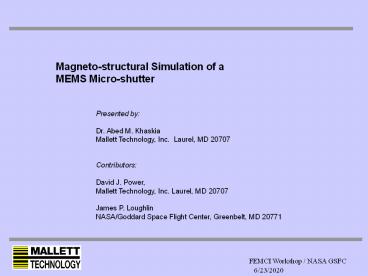FEMCI 05062004 A M Khaskia Mallett Technology - PowerPoint PPT Presentation
Title:
FEMCI 05062004 A M Khaskia Mallett Technology
Description:
Micro-shutters are transmissible filters in a space-based Multi-object Spectrograph (MOS) ... No hysteresis magnetic effect are addressed. ... – PowerPoint PPT presentation
Number of Views:25
Avg rating:3.0/5.0
Title: FEMCI 05062004 A M Khaskia Mallett Technology
1
Magneto-structural Simulation of a MEMS
Micro-shutter
Presented by Dr. Abed M. Khaskia Mallett
Technology, Inc. Laurel, MD 20707 Contributors
David J. Power, Mallett Technology, Inc.
Laurel, MD 20707 James P. Loughlin NASA/Goddard
Space Flight Center, Greenbelt, MD 20771
2
Magneto-structural Simulation of a MEMS
Micro-shutter
Agenda
- Background
- Problem Definition
- Analysis Challenges
- Finite Element Analysis Approach
- Analysis Models
- Finite Element Analyses Results
- Discussions and Conclusions
3
Magneto-structural Simulation of a MEMS
Micro-shutter
Background
- Micro-shutters are transmissible filters in a
space-based Multi-object Spectrograph (MOS). They
form an array of addressable pixels requiring
open and closed positions. Each is about 100X100
um. - Three-layer structure aluminum with .5 um,
iron-cobalt with .2 um, and silicon nitride with
.2 um.
4
Magneto-structural Simulation of a MEMS
Micro-shutter
Background
- Its operation involved a large 90o rotation
against a torsion spring. - Manufactured using MEMS technology.
5
Magneto-structural Simulation of a MEMS
Micro-shutter
Background
- Earlier concepts involved electro-static
actuation methods requiring voltages which were
too high for space applications. - Magnetic Actuation is being considered. An
animation created in Maya by Tim Carnahan of
NASA/GSFC illustrates the concept of magnetic
actuation.
6
Magneto-structural Simulation of a MEMS
Micro-shutter
Problem Definition
- Create a finite element simulation capable of
modeling the behavior of a micro-shutter as a
tri-pole magnet is traveling adjacent to it. - Finite element models should predict the magnetic
field applied onto the array and calculate the
applied forces on the shutters. - Finite element models should predict the
structural response of the micro-shutter in terms
of deformation, stresses and reactions at the
torsion bar support.
7
Magneto-structural Simulation of a MEMS
Micro-shutter
Analysis Challenges
- Magnetic problem size, relative sizes and open
domain issues. - Magnet movement as a result of which the field is
also moving. - Magnetic model air morphing and re-meshing.
- Models and solution dimensionality, i.e. 2-D
versus 3-D. - Structural large deformation and large strains.
- Mesh size and consistency between fields.
8
Magneto-structural Simulation of a MEMS
Micro-shutter
Analysis Challenges
- Coupling of the magnetic and structural fields.
Two coupling approaches direct or matrix and
load vector or sequential method
Direct
Sequential
9
Magneto-structural Simulation of a MEMS
Micro-shutter
Finite Element Analysis Approach
- 2-D magnetic analysis, and hybrid 2 and 3-D
structural analysis. - Two-model magnetic analysis. Field global model
with the magnet and local sub-model without the
magnet. - Enforce compatibility of potential between both
model. - Structural model uses 2-D plane stress and a 3-D
beam for the torsion bar. Compatibility between
both domains is enforced using MPCs. - Parametric modeling to facilitate morphing and
re-meshing.
10
Magneto-structural Simulation of a MEMS
Micro-shutter
Finite Element Analysis Approach
11
Magneto-structural Simulation of a MEMS
Micro-shutter
Analysis Models
Magnetic Global Field Model
12
Magneto-structural Simulation of a MEMS
Micro-shutter
Analysis Models
Magnetic Local Sub-model
13
Magneto-structural Simulation of a MEMS
Micro-shutter
Analysis Models
Hybrid Structural Model
14
Magneto-structural Simulation of a MEMS
Micro-shutter
Analysis Models
Model Parameters
15
Magneto-structural Simulation of a MEMS
Micro-shutter
Finite Element Analyses Results
Sub-model / Magnetic Position - Animation
16
Magneto-structural Simulation of a MEMS
Micro-shutter
Finite Element Analyses Results
Micro-shutter Position - Animation
17
Magneto-structural Simulation of a MEMS
Micro-shutter
Finite Element Analyses Results
Magnetic Flux and Micro-shutter at 90o Position
18
Magneto-structural Simulation of a MEMS
Micro-shutter
Finite Element Analyses Results
Von-Mises Stress at 90o Position
19
Magneto-structural Simulation of a MEMS
Micro-shutter
Finite Element Analyses Results
Hinge Moment and Micro-shutter Rotation Angle
20
Magneto-structural Simulation of a MEMS
Micro-shutter
Discussions and Conclusions
- Models and procedures for analyzing the
magneto-structural behavior of a MEMS
micro-shutter with hybrid two and three
dimensional models are created. The mixing of two
and three dimensional elements in the same
analysis database is found challenging. A
significant milestone is reached in stabilizing
the solution process in this database. - The application of the sub-modeling approach to
pass magnetic field potential from the field
model to the local magnetic model is the key for
the success of the modeling approach presented. - Two approaches are tried for solving the
magneto-structural models the directly coupled
and the sequentially coupled approached. Although
the directly coupled is mathematically more
rigorous, it does not converge, and the
sequentially coupled approach converges and is
found numerically more stable.
21
Magneto-structural Simulation of a MEMS
Micro-shutter
Discussions and Conclusions
- The reaction forces, reaction moment and the
rotation of the micro-shutter shows numerical
noise which is more sever in coarser finite
element meshes. - All models and procedures created use parametric
representation of model geometry and loading
sequences and as such they provide good tools for
what-if analysis scenarios. - The finite element results correlate closely with
the lab results for magnetic actuation. - The peak values for reaction forces and the
moment at the hinge are consistent with those
obtained by NASAs analyst in different analysis. - No hysteresis magnetic effect are addressed. This
could be significant for subsequent actuation of
the micro-shutter, which will be incorporated in
a future modeling effort.
22
Magneto-structural Simulation of a MEMS
Micro-shutter
- Acknowledgments / Notes
- The Authors thank NASA GSFC for Supporting the
Analysis work involved - We recognize the contribution of Bill R. Bulat of
ANSYS, Inc. and Matthew J. Mehalic of Mallett
Technology - A complete technical paper will be published in
the 2004 International ANSYS Conference































